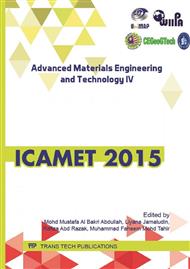p.79
p.83
p.87
p.93
p.101
p.106
p.111
p.116
p.121
Effect of Loading Amount of Glucose Precursor on Mesoporous Carbon Surface Area for Supercapacitor Electrode Application
Abstract:
Effect of glucose loading on the synthesis mesoporous carbon had been studied using hard template method where mesoporous silica SBA-15 was used as a template. To obtain a large pore of mesoporous carbon sample, a large pore of silica template was used. A series of mesoporous carbon sample was synthesized by loading different amounts of glucose (2.5g, 5.0g and 10.0g) as a carbon precursor to ensure that the template was fully impregnated with precursor. After treatment process, the surface area of carbon samples were measured with Brunauer-Emmett-Teller (BET) analysis and it shows that higher amount of glucose gives higher surface area due to the large pore of the template used. The samples then were tested with cyclic voltammetry technique at different scan rates (10, 20, 30 and 50 mVs-1) in 6M KOH electrolyte. It reveals that higher surface area samples show a higher specific capacitance with 119 F/g at slow scan rate 10 mVs-1.
Info:
Periodical:
Pages:
101-105
Citation:
Online since:
May 2016
Price:
Сopyright:
© 2016 Trans Tech Publications Ltd. All Rights Reserved
Share:
Citation:


